In Singapore, confinement meals blend traditional Chinese, Malay, Indian, and Peranakan influences, reflecting the country’s diverse culture. These nourishing dishes emphasize warming ingredients like ginger, turmeric, and coconut, often made with herbal remedies to support postpartum recovery. Families and communities actively participate in preparing and maintaining these rituals, which help new mothers reconnect with their cultural roots. To discover how these vibrant traditions continue to evolve today, explore the rich history and modern adaptations behind Singapore’s confinement practices.
Key Takeaways
- Confinement meals in Singapore blend Chinese, Malay, Indian, and Peranakan influences, reflecting its multicultural heritage.
- Traditional ingredients like ginger, turmeric, and herbs are used to promote recovery and nourish postpartum mothers.
- Herbal remedies such as ginseng and angelica root are prepared via boiling to support healing and boost immunity.
- Family and community play vital roles in preparing, assisting, and preserving confinement rituals and cultural practices.
- Modern adaptations incorporate healthier ingredients and fusion techniques while maintaining traditional significance.
The Origins and Significance of Confinement Practices in Singapore
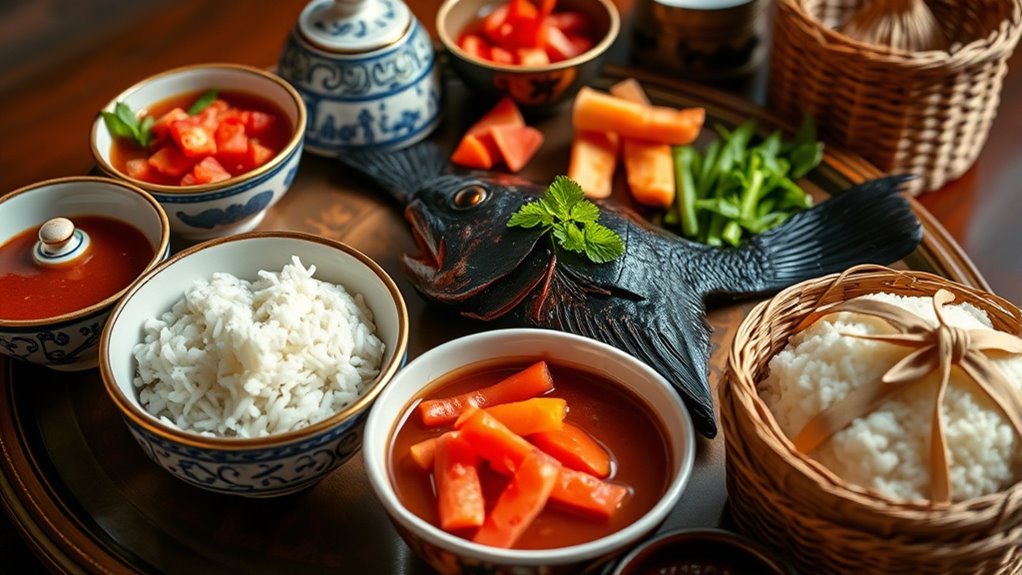
Confinement practices in Singapore have deep roots in traditional Chinese customs, introduced to help new mothers recover and regain strength after childbirth. These customs emphasize rest, warmth, and proper nutrition, believing they prevent illness and promote healing. Historically, confinement was seen as essential to ensure a mother’s physical and emotional well-being, reflecting a cultural value placed on family and health. The practice also serves to protect both mother and baby from external influences and illnesses during vulnerable times. Over time, confinement became a cultural ritual passed down through generations, with communities emphasizing the importance of adhering to specific routines and dietary guidelines. Today, these practices continue to hold significance, blending traditional beliefs with modern healthcare to support new mothers in Singapore. Incorporating traditional dietary elements, such as nutrient-rich foods, is also considered beneficial in aiding postpartum recovery.
Traditional Ingredients and Dishes in Singaporean Confinement Meals
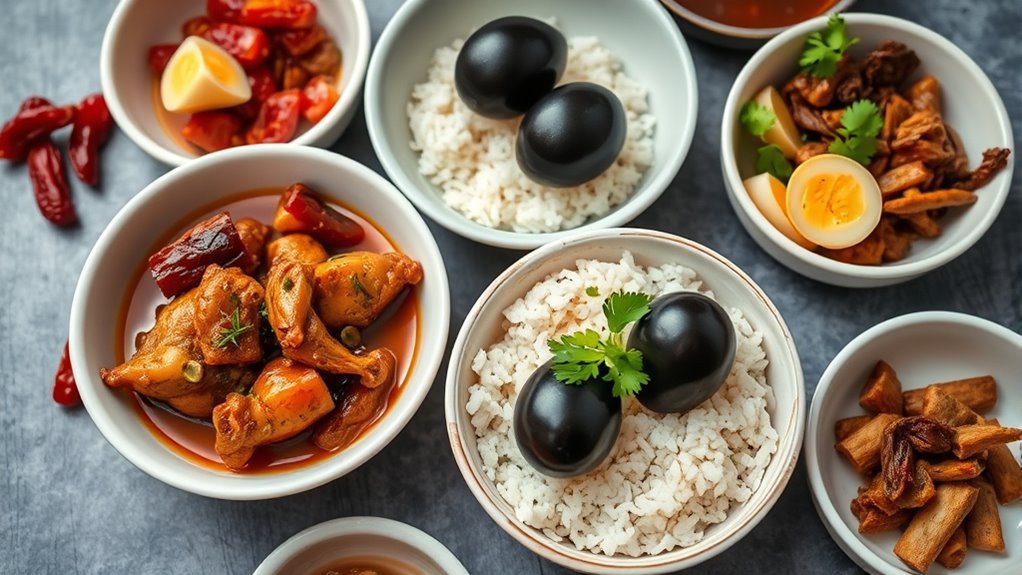
During your confinement period, traditional herbs and spices play a crucial role in boosting your recovery and well-being. You’ll find healing soups and broths that are carefully prepared to nourish your body and restore energy. These ingredients and dishes are essential to maintaining the cultural significance of Singaporean confinement meals. Incorporating mindful decluttering strategies can also help create a calm and organized environment conducive to recovery.
Traditional Herbs and Spices
Traditional herbs and spices play a vital role in Singaporean confinement meals, believed to restore strength and promote healing after childbirth. You’ll find ingredients like ginger, tong cai (water dropwort), and Chinese angelica root commonly used for their warming properties. These herbs are thought to improve blood circulation, alleviate pain, and boost energy levels during recovery. Spices such as pepper and cinnamon add flavor and are believed to support digestion and circulation as well. Often, these herbs are incorporated into teas, herbal poultices, or added to stews and rice dishes, blending taste with tradition. By using these ingredients, you’re not just enhancing flavor but also embracing age-old practices aimed at restoring balance and health during the postpartum period. Additionally, color accuracy impacts how vibrant and natural the dishes appear, enhancing the overall sensory experience during meals.
Healing Soups and Broths
Healing soups and broths form the cornerstone of Singaporean confinement meals, using nutritious ingredients believed to accelerate recovery and restore energy. These warm, comforting dishes are packed with herbs, roots, and meats that promote healing and boost vigor. As you enjoy each spoonful, you’re nourishing your body from within, helping to rebuild strength after childbirth. The rich aroma and smooth texture soothe your senses, providing comfort during a vulnerable time.
You may feel a profound sense of care and tradition in every sip, connecting you to generations of women who relied on these remedies. These soups serve not just as nourishment but as a symbol of love and support.
- Replenishing lost energy with nourishing broths
- Healing from within through medicinal herbs
- Embracing cultural heritage with every spoon
Herbal Remedies and Their Role During Confinement
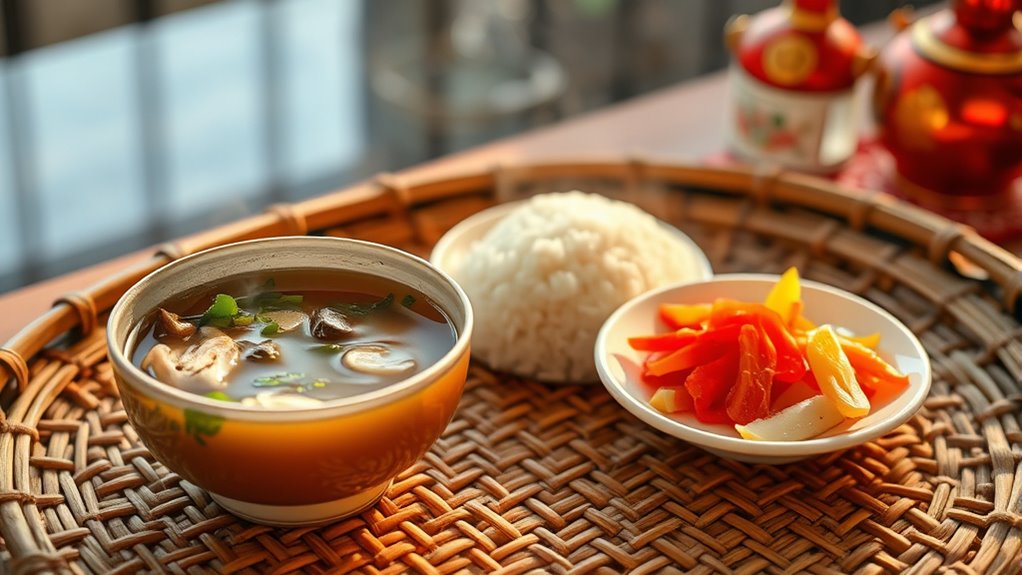
Herbal remedies play a crucial role during confinement, using traditional ingredients believed to restore strength and balance. You’ll find herbs like ginseng and ginger are commonly used for their health benefits, such as boosting immunity and improving circulation. Learning how these herbs are prepared and used can deepen your understanding of their significance in Singaporean confinement practices. In addition, the use of nutrient-rich ingredients in herbal remedies is believed to enhance recovery and overall well-being during this special period.
Traditional Herbal Ingredients
During the confinement period, herbal ingredients play a crucial role in promoting recovery and restoring strength. These traditional herbs are carefully chosen to support your body’s healing process and boost essential energy. You might find ingredients like ginger, which warms and invigorates, or dang gui, known for nourishing blood and improving circulation. Other herbs such as tong cao help detoxify and strengthen the immune system. An understanding of ethical hacking principles highlights the importance of careful assessment and protection of sensitive information, which parallels the need for careful selection and preparation of herbal remedies. These ingredients aren’t just about health—they carry cultural significance, connecting you to generations of tradition. They evoke feelings of comfort, care, and resilience, reminding you that healing is a holistic journey. As you consume these herbal remedies, you embrace a time-tested approach that values natural healing, tradition, and preserving your well-being during this important recovery phase.
Health Benefits Explored
Have you ever wondered how traditional herbal remedies support your recovery during confinement? These herbs are believed to boost your immune system, improve blood circulation, and promote faster healing. For example, ingredients like ginger and tongkat ali are known for their warming properties, helping to dispel cold and reduce inflammation. Some herbs also aid digestion and increase energy levels, which are vital during postpartum recovery. Many believe that herbal remedies balance your body’s yin and yang, restoring harmony after childbirth. Scientific studies suggest certain herbs contain antioxidants and anti-inflammatory compounds that may support tissue repair and reduce discomfort. Additionally, these herbal practices often incorporate the concept of aura energy, aiming to harmonize the body’s subtle fields for overall wellness. While they’re often used alongside proper nutrition and rest, herbal remedies are a cornerstone of traditional confinement practices aimed at helping you regain strength and wellness.
Preparation and Usage
Preparing herbal remedies for confinement involves careful selection of ingredients and precise methods of preparation to maximize their healing properties. You might boil herbs like angelica root, ginger, or sesame seeds to create nourishing broths. The preparation process often includes:
- Mindfully selecting fresh, high-quality herbs to guarantee potency.
- Following traditional recipes carefully to preserve their health benefits.
- Consuming remedies warm to promote circulation and comfort.
These remedies are more than just food—they’re a source of strength, healing, and tradition. By preparing them with care and respect, you honor your body’s needs during recovery. Incorporating top-rated herbal ingredients can enhance the effectiveness of your confinement meals. The act of brewing and consuming these herbal solutions connects you to a rich cultural heritage, offering comfort and reassurance in your confinement period.
Regional Influences Shaping Confinement Cuisine
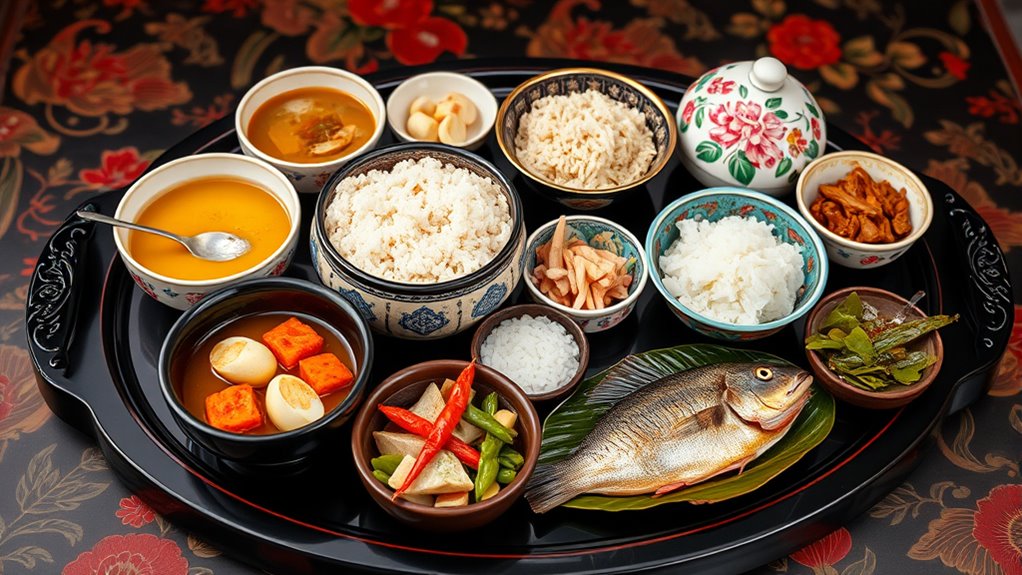
Regional influences play a significant role in shaping Singapore’s confinement cuisine, reflecting the country’s diverse cultural tapestry. You’ll notice Chinese, Malay, and Indian flavors blending seamlessly in confinement dishes. Chinese traditions emphasize warming ingredients like ginger and sesame, believed to restore energy and balance after childbirth. Malay influences introduce aromatic spices and herbs, adding depth to the meals. Indian elements bring in turmeric and cumin, which are thought to promote healing. These regional ingredients and cooking techniques come together to create nourishing, flavorful dishes that honor different cultural beliefs about recovery. By incorporating diverse spices, herbs, and cooking styles, confinement meals in Singapore become a reflection of the country’s multicultural identity, ensuring new mothers receive a well-rounded, culturally meaningful nutritional boost. Additionally, the use of cybersecurity measures in the food industry helps protect traditional recipes and ensure the safety of ingredients used in these cultural dishes.
Modern Adaptations of Traditional Confinement Recipes
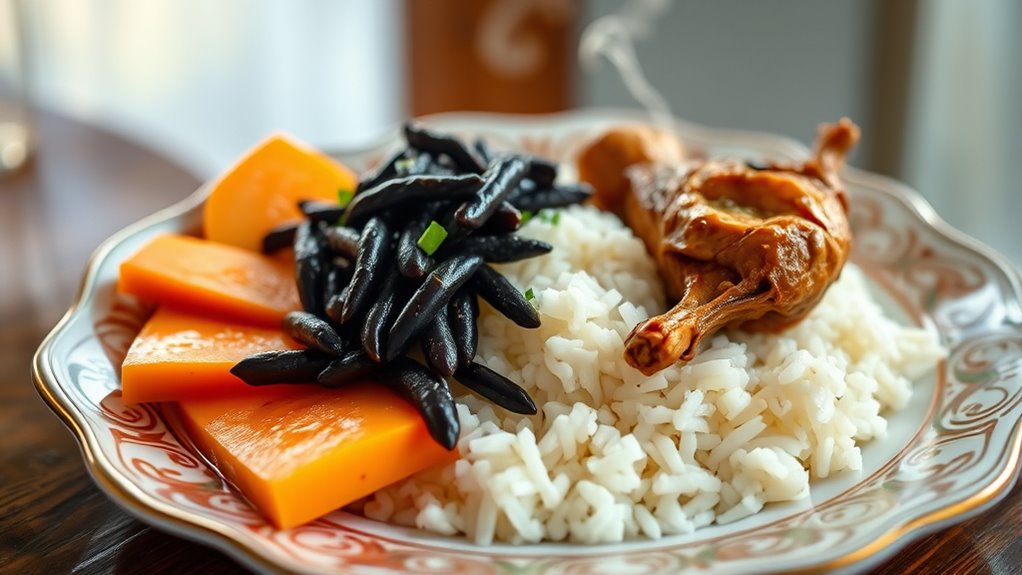
Modern adaptations of traditional confinement recipes in Singapore blend age-old wisdom with contemporary culinary trends, making these nourishing dishes more accessible and appealing to today’s new mothers. Chefs now incorporate healthier ingredients, such as low-sodium broths and organic herbs, while still honoring cultural roots. These innovative twists often feature modern presentation, making the dishes more visually appealing and enjoyable. You might find fusion dishes that combine local flavors with international techniques, creating a comforting yet exciting experience. The goal is to preserve the essence of postpartum nourishment while catering to modern tastes and dietary needs. Additionally, safety in shark-infested waters principles guide some practitioners in ensuring the safe preparation of seafood ingredients used in these recipes. You can feel confident knowing that these adaptations continue to support recovery, bonding, and wellness, all while fitting seamlessly into your busy, contemporary lifestyle.
Family and Community Involvement in Postpartum Care

Family and community play an essential role in postpartum care, providing emotional support, practical help, and cultural continuity during a challenging yet rewarding time. Your family members often step in to assist with daily chores, ensuring you can rest and recover. They may prepare traditional confinement meals or bring supplies, helping you stay connected to cultural practices. Community members, such as friends or neighbors, offer encouragement and companionship, easing feelings of isolation. Their involvement reassures you that you’re not alone and reinforces the communal bonds that are crucial during this period. Additionally, understanding the freeze-drying candy process can be a fun way to explore traditional treats and preserve flavors, adding a sweet touch to your postpartum experience. Their involvement helps create a nurturing environment that supports your physical and emotional well-being, making the postpartum experience more manageable and meaningful.
The Cultural Preservation of Confinement Rituals Amid Modernity
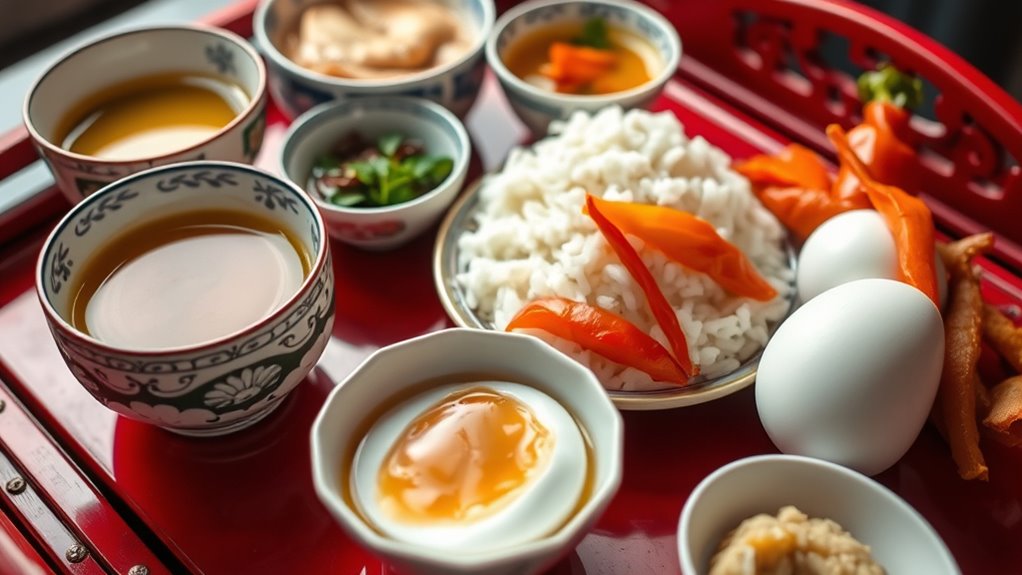
As society advances and lifestyles become more fast-paced, preserving traditional confinement rituals remains an essential way to connect new mothers to their cultural roots. These rituals offer comfort, strength, and a sense of continuity during a vulnerable time. Despite modern influences, many families actively uphold these customs, passing them down through generations. You might find families preparing traditional confinement meals, practicing specific postpartum care routines, or holding ceremonial practices that honor heritage. These acts serve as a reminder of identity and resilience, helping mothers feel grounded.
- Reaffirming cultural values during a transformative phase
- Strengthening bonds between generations through shared practices
- Providing emotional comfort amid rapid societal change
How Confinement Meals Reflect Singapore’s Multicultural Heritage
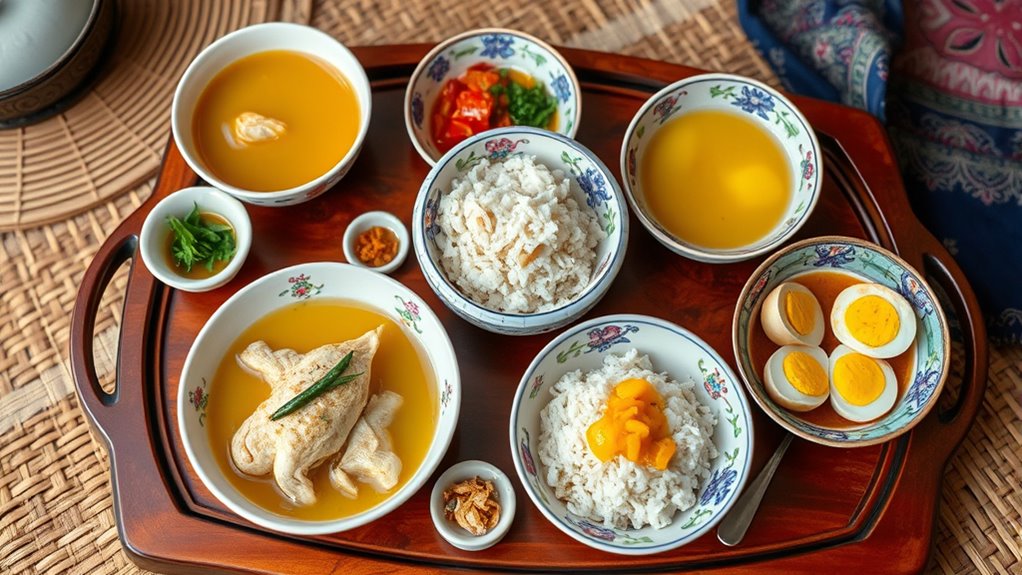
Singapore’s rich tapestry of cultures is vividly reflected in its confinement meals, which combine ingredients and culinary techniques from Chinese, Malay, Indian, and Peranakan traditions. You’ll notice a blend of flavors, like ginger and sesame from Chinese cuisine, turmeric and coconut from Malay dishes, and spices like cumin from Indian recipes. These meals symbolize unity amid diversity, showcasing how different communities contribute to a shared heritage. Here’s a quick look at some key influences:
| Culture | Typical Ingredients | Signature Dishes |
|---|---|---|
| Chinese | Ginger, sesame, soy | Chicken herbal soup |
| Malay | Coconut, turmeric | Lemang, fish curry |
| Indian | Cumin, turmeric, spices | Lentil dhal, spiced vegetables |
| Peranakan | Lemongrass, pandan | Nonya laksa, acar |
This culinary fusion highlights Singapore’s multicultural identity.
Frequently Asked Questions
How Do Confinement Meals Vary Among Singapore’S Ethnic Groups?
You’ll notice that confinement meals in Singapore differ among ethnic groups, reflecting their unique traditions. For example, Chinese confinement diets focus on nourishing soups, ginger, and nutritional herbs for recovery. Malay meals emphasize spicy, flavorful dishes with turmeric and coconut milk, while Indian confinement cuisine includes hearty lentils, spices, and warm curries. These variations honor cultural beliefs about health and healing, ensuring new mothers receive tailored, comforting nourishment.
Are There Specific Restrictions During Confinement Meals in Singapore?
During confinement meals in Singapore, you’re often restricted from consuming certain foods like raw or cold items, which are believed to affect recovery. You might also avoid spicy foods or those that are considered “cooling,” depending on your cultural background. These restrictions aim to promote healing and balance within your body. Always follow your traditional guidelines or your healthcare provider’s advice to guarantee a safe and effective confinement period.
How Has Globalization Influenced Singapore’S Confinement Cuisine?
Globalization has woven Singapore’s confinement cuisine into a vibrant tapestry, blending traditional flavors with international influences. You might notice ingredients like herbs or spices from Asia, Europe, or the West, enriching the dishes and making them more diverse. This culinary fusion reflects Singapore’s open-mindedness, allowing new tastes to enhance comfort and healing during confinement. As a result, your meals become a delightful journey across cultures, fostering unity and celebrating global interconnectedness.
What Role Do Confinement Meals Play in Postpartum Recovery?
You might think confinement meals are just about tradition, but they play a crucial role in postpartum recovery. These nourishing dishes help restore your strength, boost your energy, and support healing after childbirth. By providing essential nutrients, they also help balance your body’s needs during this vital period. Embracing these meals helps you recover faster and feel more resilient as you adjust to new motherhood.
Are Confinement Meal Practices Consistent Across Different Singapore Generations?
Like a delicate tapestry woven through time, confinement meal practices in Singapore reveal both tradition and change. You’ll find that older generations often stick to classic recipes and strict routines, emphasizing warmth and nourishment. Meanwhile, younger families might blend modern health trends with cultural roots. While core principles remain, practices evolve, reflecting Singapore’s diverse society and shifting lifestyles. So, confinement meals aren’t entirely consistent but beautifully adaptable across generations.
Conclusion
You’ll find that confinement meals in Singapore beautifully showcase its multicultural heritage, blending Chinese, Malay, and Indian traditions. Remarkably, over 80% of new mothers report feeling more cared for when family prepares these special dishes. By preserving these rituals, you help keep Singapore’s rich cultural tapestry alive, even as modern influences grow. Embracing these meals not only nurtures postpartum recovery but also strengthens your connection to your roots and community.









